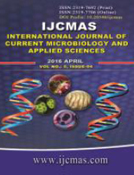


 National Academy of Agricultural Sciences (NAAS)
National Academy of Agricultural Sciences (NAAS)

|
PRINT ISSN : 2319-7692
Online ISSN : 2319-7706 Issues : 12 per year Publisher : Excellent Publishers Email : editorijcmas@gmail.com / submit@ijcmas.com Editor-in-chief: Dr.M.Prakash Index Copernicus ICV 2018: 95.39 NAAS RATING 2020: 5.38 |
Different Proteus species may vary with the type of infections they cause in both the community and hospital environments. However, in many laboratories in developing countries, differentiation of the genus Proteus into species is not generally done during bacteriological diagnosis due to high cost and special skills involved. This study aimed at determining the prevalence of different Proteus species in Nalanda Medical College and Hospital, PATNA, their antibiotic resistance pattern and how they relate to patients’ demographic data. This is a prospective study involving the analyses of clinical samples for Proteus species and determining their antimicrobial susceptibility pattern. Thirty two Proteus species were isolated from 1910 clinical specimens obtained from patients suspected of bacterial infection, giving 1.67 % prevalence of Proteus infections. Wound isolates were the highest followed by urine. Three Proteus species; P. mirabilis, P. vulgaris and P. penneri were recovered from the samples. P. mirabilis was the commonest species (59.38 %), and hence the causative species of a majority of Proteus infections followed by P. vulgaris (34.37 %), and P. penneri (6.25 %). The three Proteus species recovered were highly resistant to ampicillin, cefuroxime, netillin and pefloxacin . This study has also provided information for use in generating national data.
 |
 |
 |
 |
 |